The major difference between carbon and nylon cycling shoes is, Nylon Cycling Shoes are lighter and less stiff than carbon cycling shoes.
Riders usually make choices of cycling shoes based on their riding needs. Nylon shoes are lighter because the material – nylon – is light.
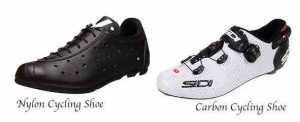
This also means that it is flexible. Some riders don’t like a stiff ride. Whereas other cyclists like the fact that a stiff shoe transfers more energy into the pedal.
For such riders, they prefer the other side of the divide and go for carbon shoes which are stiffer and heavier. So for every cyclist, it is whatever rolls your tires, so to speak.
Carbon Cycling Shoes
Cycling shoes specifically made for cycling didn’t enter production until the 1940s. The first ones were made by R.E.W Reynolds which originally was a bicycle frame-making company.
The first shoes featured leather uppers and soles with steel in the shank for efficient pedal work. By the early 2000s, the cycling world witnessed the appearance of carbon-soled shoes. Some didn’t have complete soles.
It was a mixture of carbon and nylon which resulted in shoes that were very light yet rigid in key places under the shoe. Today you now have truly carbon shoes. They are stiff, light, and ventilated.
If you are a cyclist you would do well to conduct research before you make your purchase of a cycling shoe.
And if you are looking to buy carbon Cycling Shoes, there are a plethora of shoes to buy. For example, below are Wire 2 Air Vent Carbon Road Cycling Shoes.
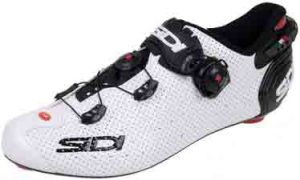
Nylon Cycling Shoes
It is impossible to diverge here with nylon cycling shoes because they share the same history as carbon shoes.
As mentioned above, at first manufacturers mixed the materials together to provide an experience that incorporates the best of both worlds.
As carbon cycling shoes picked up production in the 2000s, nylon pairs did the same.
Cyclists influenced the distinction more as there are those who preferred one to the other. Today cyclists are presented with many options to choose from.
Below is a Vittoria 1976 Classic Nylon Cycling Shoes.
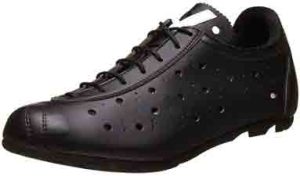
This shoe is designed for triathlon rides. Many cyclists would prefer a shoe with nylon in the sole for triathlon competitions because they’re more comfortable, less stiff and of course, the large holes for ventilation.
Each rider chooses to wear either a carbon or nylon shoe depending on the type of race and the distance.
Flexible soles are usually made of polyurethane materials which makes them pliant. They also feature lace-up closures to support adjustable flexibility. The microfiber top prevents overheating as the rider pedals outdoors.
Why this comparison?
Are you new to cycling shoes? Or do you see yourself picking up the sport as a hobby? Are you simply a curious learner who wants to add to your knowledge?
This comparison is important for you. Here are two reasons for this comparison.
- To know which shoe is better
- To know which one fits your purpose
Which shoe is better
Also if you are picking up the sport either professionally or as a hobby, it is important to understand everything you need to know about gear and outfit.
Cycling is a sport that doesn’t require touching the ground with your feet, yet it is also a sport where the shoes you wear are as important as the bicycle itself.
It is for these reasons that we need to compare the two types of shoes. You don’t want to buy a shoe that will hamper your progress in a race, or harm your feet. Every shoe you wear has to feel comfortable, and also fulfill the function you intend for it.
Which shoe fits your purpose
Another reason for this comparison is to help you know if carbon or nylon shoes are best for your purpose.
Are you a road cyclist? Do you intend to go into a triathlon competition? The shoe you buy will affect how you perform.
For example, cycling shoes with cleats are for racing. Buying one without a cleat may set you back and make you lose your race.
There are road cycling shoes made of stiff nylon, with composite or carbon fiber soles. There are also road cycling shoes with carbon soles offering stiff features for efficiency.
You may be a rider who wants efficiency but won’t like to sacrifice comfort for it. After going through this comparison you should be able to make a more informed decision on which to buy.
Similarities between nylon cycling shoes and carbon cycling shoes
Both shoes are used by cyclists and here are the similarities between the shoes:
- Both can have cleats
- They feature the same closures
- Can be used for more than one type of cycling
- Highly ventilated
- Lack of tread
Both can have cleats
Professional cyclists prefer shoes that are designed for races. When they practice or just ride for fun they may want to feel the same pressure as when they race. Here’s where cleats come in.
Both nylon and carbon shoes feature grooves under them. This is a mechanism that allows the shoe to clip into the pedal. The pedal itself is designed with a cleat that your shoe hooks into.
This keeps your feet in a solid and consistent position. With the cleat, you don’t have to reposition your feet every now and then. With a few pedal strokes, you are propelled for longer.
I have personally come across just one or two solid and durable cycling shoes without cleats. The majority that is manufactured have cleats. This is one thing nylon and carbon shoes share in common.
Shoe cleats recessed in the shoe.

Same closures
Each manufacturer of cycling shoes features closures that make them unique, but on the whole, cycling shoes – nylon and carbon – feature either lace closures or in addition to dials for tightening the laces to your desired fit.
In the image below (Giro Regime Carbon shoes) you see a combination of lace and dial closure.
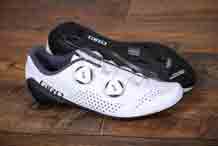
Below is a nylon cycling shoe (Fizik Tempo Overcurve R5) with a combination of the dial and lace-up closure as well.

Riders need all the composure, close fit, and efficiency they can get when riding. Especially for road riding.
The lace-up closure or a combination with a dial ensures that they do not need to stop every now and then to adjust their shoes. Furthermore, it allows an efficient working of the cleat system in the pedal.
Of course, you will find either nylon or carbon shoes that feature just one type of closure.
Both can be used for more than one type of cycling
There are different types of cycling: road cycling, mountain cycling, and recreational cycling.
Both nylon and carbon shoes can be used for major types of cycling like road and recreation cycling.
This is because shoes come with extra features that make them suitable for more than one type of cycling.
Road Cycling requires shoes that are sturdy and stiff. But even flexible shoes like nylon cycling shoes can be used too. Certain nylon or carbon-soled shoes feature treads for more traction which makes them suitable for mountain cycling.
Below is a Vittoria Alise MTB cycling shoe with nylon treaded soles. This shoe is suitable for mountain cycling.
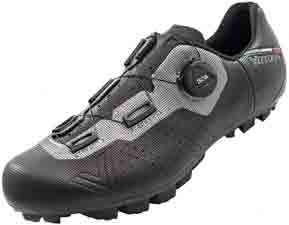
High ventilation
Both types of cycling shoes feature ventilation. The uppers are usually made of synthetic UP waterproof materials.
The measure of tiny grooves in both nylon and carbon shoes varies from one product to the other.
If you live in an area where the weather is hot, or you intend to ride for sport in summer, you don’t have to worry about feeling uncomfortable on your feet.
For example, take a look at the uppers of these Tommaso Pista Aria Cycling Shoes. It features knitted material that’s sure to let in a lot of air as you ride.
This is one attribute that both nylon and carbon cycling shoes have in common.
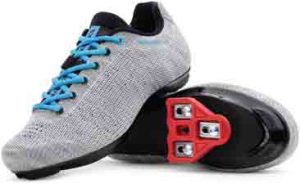
Lack of tread in most shoes
Most nylon and carbon shoes share a lack of tread in the soles in common. This is so because cyclists are mostly on their bicycles during tours or competitions.
Besides, most of the sole of the shoe is rigged with grooves for cleats.
Mountain cycling shoes are an exception. These ones need traction so they feature treads.
Comparison between nylon cycling shoes and carbon shoes
The differences are as follows:
- Flexibility
- Durability
- Price
- Resistance to cracking
Nylon cycling shoes vs carbon shoes: Flexibility
One of the most important differences between nylon cycling shoes and carbon cycling shoes is flexibility. Carbon shoes are stiffer than nylon shoes.
Note that this does not significantly affect performance. Study by the Department of Mechanical Engineering, University of Colorado shows that there is no difference between the performance of less stiff and stiffer road cycling shoes.
The study was conducted on a few riders. Perhaps the result will be different if a larger number of riders are involved.
However, most of the effect is felt on the feet with continuous use over a long period of time.
And a less flexible carbon show soon begins to crack in the middle where the feet flex. This tends to be both a difference and a disadvantage for carbon shoes.
Nylon cycling shoes vs carbon shoes: Durability
Here’s another difference. Nylon shoes are actually less durable than carbon shoes over the long haul. Materials matter, and since the materials used are different, so do the results you get from using the shoes.
Carbon shoes are always high-end shoes, which makes them worth their money. They last longer especially if they are composites.
Nylon cycling shoes vs carbon shoes: Price
Another difference is price. Investing in cycling shoes takes a lot of forethought because you have a hierarchy of needs the shoe must satisfy.
In order to meet these needs, you are going to shovel money out. The better the shoe, the higher the price for it. Since carbon shoes feature better and quality materials, they are more expensive.
Carbon cycling shoes can cost as much as $110 or even higher. Whereas nylon shoes are less priced. Some sell as low as $22.
This pricing is a general thing however as there are some nylon shoes that are sold in the $100 range too. For example, this heavily ventilated Vittoria 1976 Classic Nylon Cycling Shoes is $179.99
Nylon cycling shoes vs carbon shoes: Resistance to cracking
Stiffer materials are prone to cracking easier than less stiff materials. This applies to the two shoes in this comparison.
Carbon shoes are stiffer and less pliant making them crack along the top of the toe area after some time of use. It is worse if the carbon is inferior.
On the other hand, nylon cycling shoes are more resistant to cracking. Composite shoes seem to be in-between the cracking phenomenon. Generally, nylon shoes provide more durability in this area.
They flex easily and leave less trace of wear in the toe area.
Which is better?
Nylon Cycling Shoes are better. Some cyclists would disagree but here’s where it becomes subjective.
However, considering the difference between the two shoes which also translates to advantages, I’d say nylon shoes have the upper hand.
In studying the shoes, lack of plenty of stiffness doesn’t significantly affect the performance on the road. Hence, a cyclist can choose a nylon shoe and still enjoy riding, whether on the road or recreationally.
Conclusion
Are you a fan of recreational or road cycling? Do you love looking at the part by wearing gear that makes your sport even more enjoyable?
Then you no doubt have found this comparison beneficial. If you have wondered which shoe to buy for cycling or if you aren’t even aware of the difference, it is important to consider the comparisons here carefully before buying that cycling shoe you so much love.
Lastly, be sure to test the shoes before you buy them. And if you are ordering online, take your time to be certain you are purchasing a size that fits you properly.
After purchase, do a test run of the shoe by learning how to use the cleats, and ride around with it to break them in. If you have the funds for it, you may even purchase a pair of each type.
Related:
- Red Tape vs Skechers
- Aquaseal vs Shoe Goo
- Eva vs Rubber Soles
- Vans Classic Slip-Ons vs Asher
- Fracap vs Paraboot
This page may contain affiliate links.
To support the content and the knowledge I share here, I earn from qualifying purchases from Amazon at no extra cost to you.
